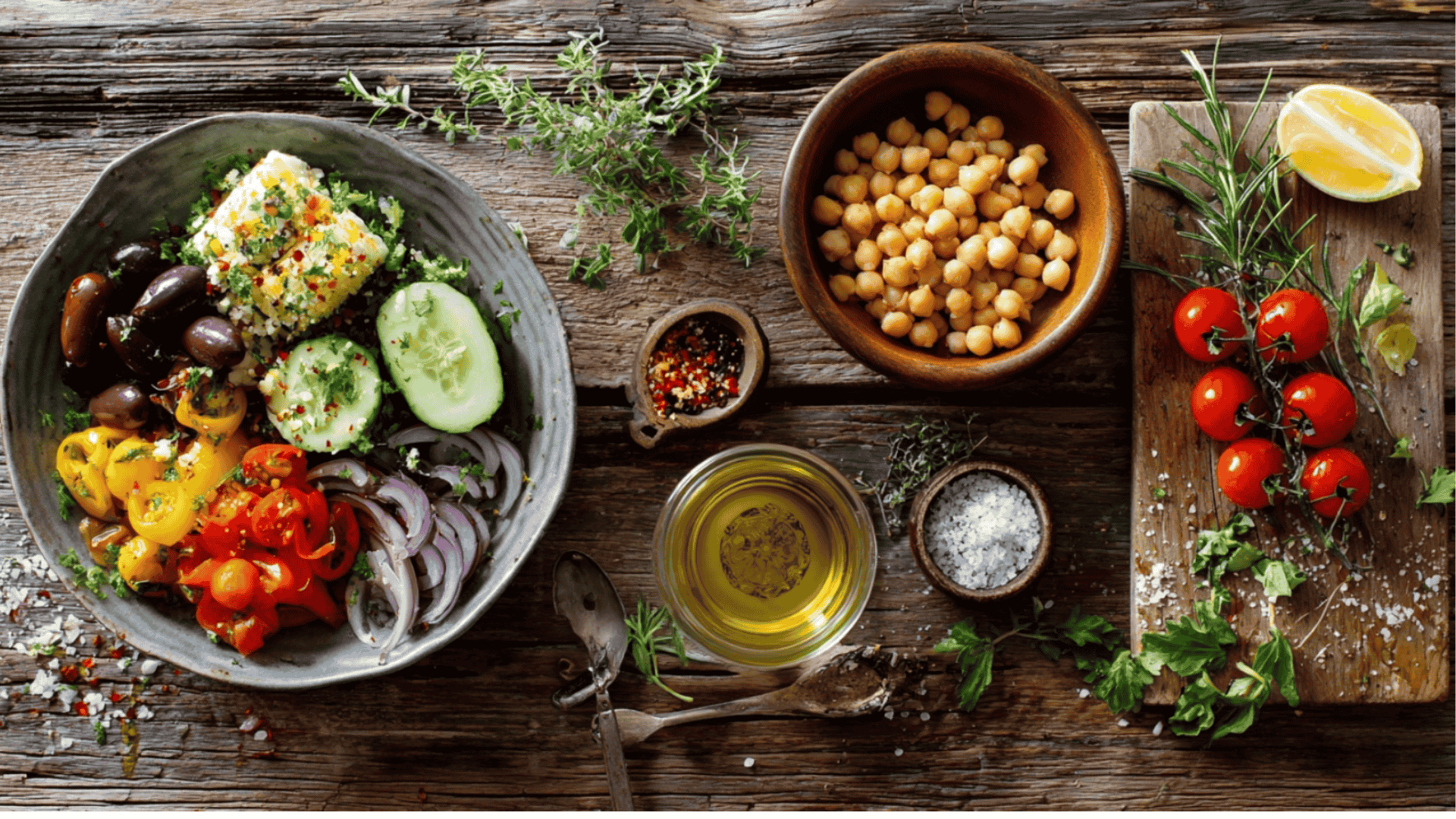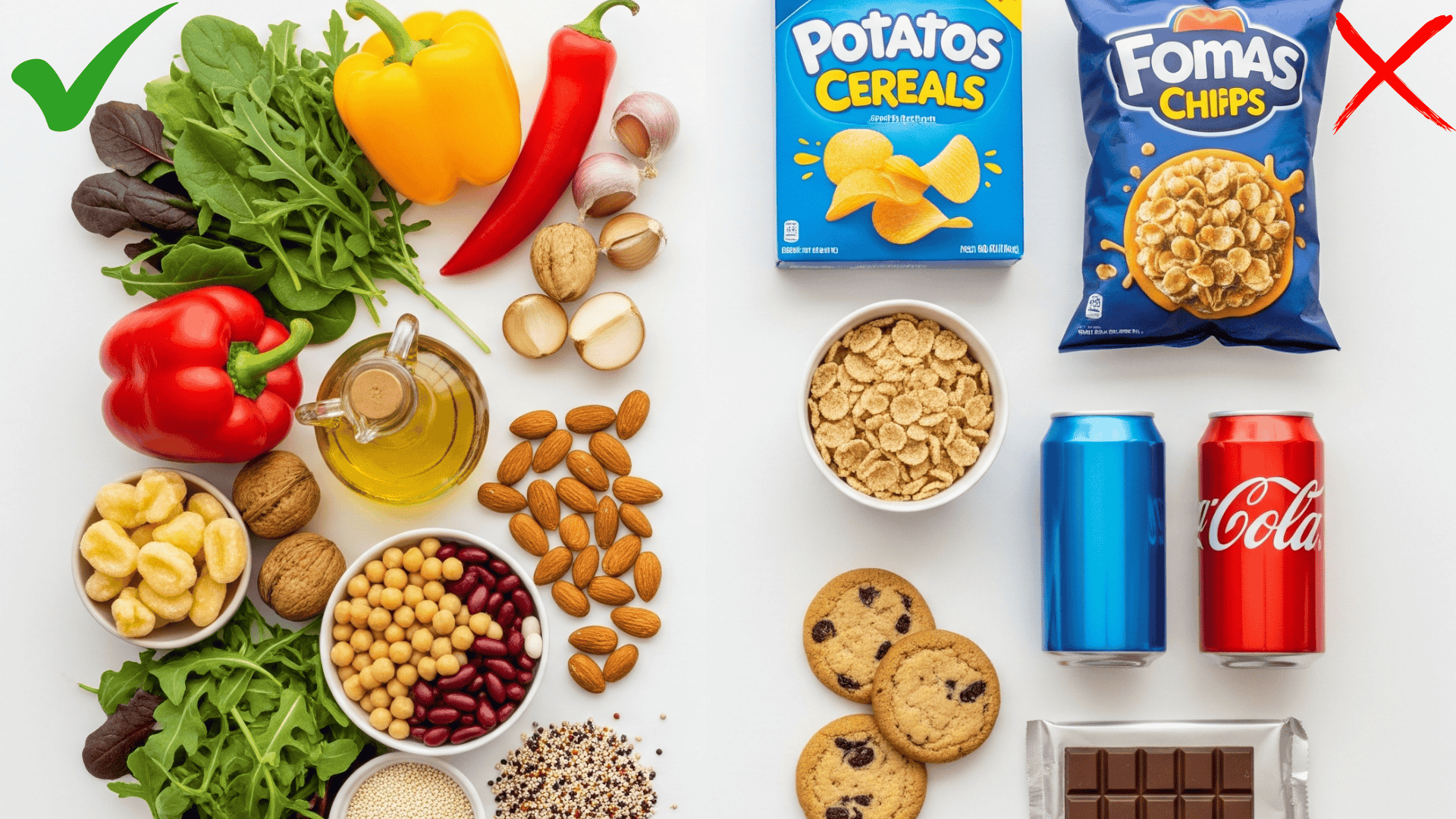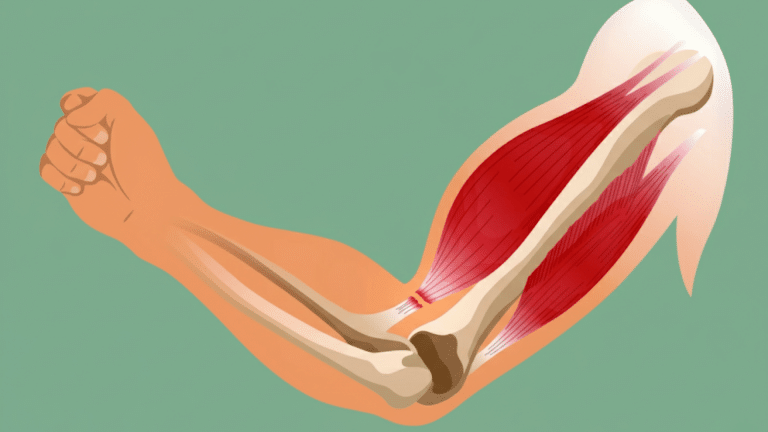Tired of restrictive diets that leave you hungry and unsatisfied?
The vegetarian Mediterranean diet offers a fresh approach that actually works. This eating style combines the heart-healthy benefits of Mediterranean cuisine with the nutritional benefits of plant-based foods.
You’ll enjoy colorful meals packed with olive oil, fresh vegetables, legumes, and whole grains.
Studies show that this diet can reduce the risk of heart disease, help manage weight, and boost your mood. Plus, you get to eat delicious food while improving your health.
Ready to change how you eat? Let’s explore this simple and flexible lifestyle that makes healthy eating enjoyable and sustainable in the long term.
Also read: What Do Yogis Eat? Munch Mindfully, Feel Magical!
What’s the Vegetarian Mediterranean Diet All About?
The Mediterranean diet is famous for its focus on whole foods and healthy fats.
It’s based on how people in places like Crete and Sicily used to eat a lot of vegetables, fruits, and grains, with a little cheese or yogurt.
The vegetarian version skips meat and fish but keeps the good stuff.
You’ll load up on lentils, chickpeas, nuts, and maybe some eggs or dairy if you’re not vegan. It’s simple, flexible, and oh-so-delicious.
Core Principles of the Diet
This isn’t a rigid diet with a long list of rules; it’s a lifestyle that’s easy to love. The focus is on whole, minimally processed foods and enjoying meals with others. Here’s what it’s all about:
-
Load up on plant foods like greens, tomatoes, and beans.
-
Use extra-virgin olive oil as your primary fat for cooking and drizzling.
-
Flavor dishes with herbs like basil or rosemary instead of salt.
-
Share meals with friends or family to make eating a joyful experience.
-
Stay active with simple habits like walking or gardening.
Why It’s So Good for You
Science loves this diet. Studies, like the big PREDIMED trial, show it’s a winner for your health.
It can lower your risk of heart disease, help you manage your weight, and even keep your blood sugar in check.
The veggies and olive oil are packed with antioxidants that fight inflammation. Plus, all that fiber from beans and grains keeps your gut happy.
Some folks in Mediterranean “blue zones” live longer thanks to diets like this. Oh, and it might even boost your mood!
What to Eat (and What to Skip)
The vegetarian Mediterranean diet is like a colorful market stall, packed with fresh, wholesome ingredients. Here’s a rundown of what to enjoy:
|
Category |
Examples |
Why It’s Great |
|---|---|---|
|
Vegetables |
Spinach, zucchini, peppers, artichokes |
Packed with vitamins and fiber. |
|
Fruits |
Berries, oranges, figs, avocados |
Sweet, nutrient-rich, and antioxidant-heavy. |
|
Whole Grains |
Quinoa, brown rice, farro, bulgur |
Keeps you full and energized. |
|
Legumes |
Chickpeas, lentils, black beans, tofu |
Protein and fiber for staying satisfied. |
|
Nuts & Seeds |
Almonds, walnuts, chia, pumpkin seeds |
Healthy fats and a crunchy snack. |
|
Healthy Fats |
Extra virgin olive oil, avocados |
Heart-healthy and adds rich flavor. |
|
Herbs & Spices |
Basil, oregano, rosemary, mint |
Boosts taste without extra salt. |
|
Dairy/Alternatives |
Greek yogurt, feta, almond milk (vegan) |
Calcium and protein, or plant-based swaps. |
|
Drinks |
Water, herbal teas, fresh juices |
Hydrating and free of added sugars. |
Aim for 9-12 servings of veggies daily and mix up your choices for variety.
Foods to Limit or Avoid
You don’t have to be perfect, but cutting back on certain foods helps you stay on track.
Try to steer clear of processed snacks, like salty fake meats or chips, which can sneak in extra sodium.
Skip refined grains like white bread and sugary treats like pastries.
Fried foods or anything with trans fats? Not your friend. And go easy on sugary drinks like soda or sweetened coffee, they don’t fit the Mediterranean vibe.
Nutrients to Watch
To keep your body happy, focus on a few key nutrients:
-
Protein: Mix beans and grains, like rice and lentils, for a complete protein punch.
-
Iron: Eat spinach or pumpkin seeds with a squeeze of lemon to help your body absorb it.
-
B12: If you’re vegan, grab fortified nutritional yeast or a supplement.
-
Omega-3s: Sprinkle chia or flaxseeds on your meals since you’re skipping fish. A dietitian can help you nail this, especially if you’re worried about missing anything.
How to Follow the Vegetarian Mediterranean Diet
Starting this healthy eating style is simpler than you might think. With a few basic steps and smart kitchen choices, you can easily incorporate Mediterranean meals into your daily routine without stress or confusion.
Step-by-Step Guide to Getting Started
Jumping into this diet is easier than you think. Follow these simple steps to make it part of your routine:
-
Stock your kitchen: Fill your pantry with olive oil, canned beans, quinoa, and fresh herbs.
-
Build meals around veggies: Start with greens or roasted veggies as the star of your plate.
-
Add plant-based protein: Toss in chickpeas, lentils, or tofu every day.
-
Flavor with olive oil and herbs: Drizzle oil and sprinkle oregano for that Mediterranean magic.
-
Eat mindfully: Slow down, savor your food, and enjoy meals with others when you can.
Vegetarian Mediterranean Diet 7-Day Meal Plan
Here’s a week of simple, tasty meals. Adjust portions to fit you!
Day 1:
- Breakfast: Greek yogurt with a drizzle of honey, walnuts, and fresh berries.
- Lunch: Quinoa salad with chickpeas, cucumber, tomatoes, olives, and a lemon-olive oil dressing.
- Dinner: Lentil and veggie stew with a slice of whole-grain bread.
- Snack: Apple slices with a smear of almond butter.
Day 2:
- Breakfast: Whole-grain toast with mashed avocado and a poached egg (or tofu scramble for vegans).
- Lunch: Hummus wrap with spinach, roasted peppers, and a sprinkle of feta (or vegan cheese).
- Dinner: Eggplant parmesan (vegan cheese works too) with a side arugula salad.
- Snack: Handful of almonds and a juicy orange.
Day 3:
- Breakfast: Oatmeal with chia seeds, sliced figs, and almond milk.
- Lunch: White bean soup with kale and some whole-grain crackers.
- Dinner: Bell peppers stuffed with quinoa, black beans, and sun-dried tomatoes.
- Snack: Carrot sticks dipped in hummus.
Day 4:
- Breakfast: Smoothie with spinach, banana, almond milk, and flaxseeds.
- Lunch: Greek salad with tofu, olives, cucumber, and whole-wheat pita.
- Dinner: Mushroom barley soup with roasted zucchini on the side.
- Snack: Dates stuffed with walnuts.
Day 5:
- Breakfast: Whole-grain pita with tahini and sliced tomatoes.
- Lunch: Chickpea and veggie tagine with fluffy couscous.
- Dinner: Spinach and feta (or vegan cheese) zucchini pie with a green salad.
- Snack: Greek yogurt with pomegranate seeds (or fruit salad for vegans).
Day 6:
- Breakfast: Tofu scramble with turmeric, spinach, and whole-grain toast.
- Lunch: Roasted veggie and farro bowl with a tahini dressing.
- Dinner: Grape leaves stuffed with lentils and rice, served with cucumber-yogurt dip (use vegan yogurt if needed).
- Snack: Chia pudding with fresh peaches.
Day 7:
- Breakfast: Whole-grain pancakes topped with almond butter and fruit.
- Lunch: Falafel bowl with bulgur, tomatoes, cucumber, and a cashew-based dressing.
- Dinner: Vegan fettuccine alfredo with almond butter sauce and snap peas.
- Snack: Roasted chickpeas and a crisp pear.
Meal Prep Made Easy
Want to make this diet a breeze? Spend an hour or two prepping each week.
Cook big batches of grains like quinoa or lentils to use in multiple meals.
Chop veggies like peppers and zucchini ahead of time for quick cooking.
Blend up hummus or tahini dressing and store it in the fridge. Shop for seasonal produce; it’s cheaper and tastier.
For busy days, lean on one-pot recipes like lentil soup or sheet-pan roasted veggies.
Keep snacks like nuts or fruit in small containers for grab-and-go ease.
3 Simple Tips to Stick With It
Making any diet change can feel tough at first. These practical tips will help you stay on track, handle common challenges, and turn the vegetarian Mediterranean diet into a habit you actually enjoy.
1. Handling Common Hurdles
Worried about protein? No sweat—beans, lentils, and nuts have you covered.
On a budget? Buy grains in bulk and make your own hummus. Short on time? Spend an hour prepping on the weekend, and try one-pot meals like lentil soup.
Craving sweets? Stuff dates with walnuts for a Mediterranean treat.
2. Making It a Lifestyle
This isn’t just about food. Take a walk, do some yoga, or dance to your favorite tunes.
Eat with friends or family when you can; it’s part of the Mediterranean magic. Hit up local markets for fresh produce; it’s fun and saves cash.
3. Tools to Help You Out
Check out the “Vegetarian Mediterranean Cookbook” by Sanaa Abourezk for killer recipes.
Websites like TheMediterraneanDish.com offer a wealth of ideas.
Apps like Yummly can help with meal planning. If you want a custom plan, a dietitian from Berry Street can set you up.
Disclaimer: These resources are for informational purposes only. We are not affiliated with any mentioned books, websites, or services. Consult a healthcare professional before making dietary changes.
The Bottom Line
The vegetarian Mediterranean diet offers more than just nutritious meals; it provides a path to better health without strict rules or complicated restrictions. This flexible eating style lets you enjoy vibrant flavors while supporting your heart, weight, and overall well-being.
Why does this matter? Because sustainable health changes happen when you find joy in what you eat. This diet gives you that balance between nutrition and pleasure that most eating plans miss.
What comes next? Pick three recipes from our meal plan and try them this week. Stock your kitchen with olive oil, beans, and fresh herbs. Make one small change at a time, and watch how your energy and mood improve.
Start your Mediterranean lifestyle today, and your future self will feel the difference.
Power your progress the smart way; check out our Nutrition & Meal Plans hub for dietitian-approved ideas







